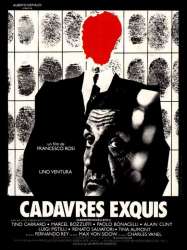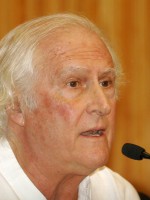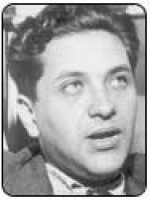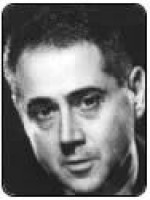Astor Piazzolla is a Actor and Sound Argentin born on 11 march 1921 at Mar del Plata (Argentine)
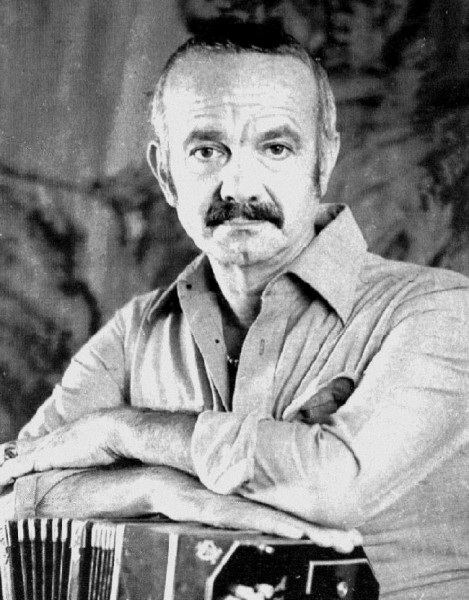
Astor Pantaleón Piazzolla (March 11, 1921 – July 4, 1992) was an Argentine tango composer, bandoneon player and arranger. His oeuvre revolutionized the traditional tango into a new style termed nuevo tango, incorporating elements from jazz and classical music. A virtuoso bandoneonist, he regularly performed his own compositions with a variety of ensembles.
Piazzolla was born in Mar del Plata, Argentina, in 1921, the only child of Italian immigrant parents, Vicente "Nonino" Piazzolla and Asunta Manetti. His grandfather, a sailor and fisherman named Pantaleón Piazzolla, had immigrated to Mar del Plata from Trani, a seaport in the southeastern Italian region of Apulia, at the end of the 19th century.
In 1925 Astor Piazzolla moved with his family to Greenwich Village in New York City, which in those days was a violent neighbourhood inhabited by a volatile mixture of gangsters and hard-working immigrants. His parents worked long hours and Piazzolla soon learnt how to take care of himself on the streets despite having a limp. At home he would listen to his father's records of the tango orchestras of Carlos Gardel and Julio de Caro, and was also exposed to jazz and classical music, including Bach, from an early age. He began to play the bandoneon after his father spotted one in a New York pawn shop in 1929.
After their return to New York City from a brief visit to Mar del Plata in 1930, the family went to live in Little Italy in lower Manhattan, and in 1932 Piazzolla composed his first tango La catinga. The following year Piazzolla took music lessons with the Hungarian classical pianist Bela Wilda, a student of Rachmaninoff, who taught him to play Bach on his bandoneon. In 1934 he met Carlos Gardel, one of the most important figures in the history of tango, and played a cameo role as a young paper boy in his movie El día que me quieras [1]. Gardel invited the young bandoneon player to join him on his current tour. Much to Piazzolla's dismay, his father decided that he was not old enough to go along. This early disappointment of not being allowed to join the tour proved to be a blessing in disguise, as it was on this tour that Gardel and his entire orchestra perished in a plane crash in 1935. In later years, Piazzolla made light of this near miss, joking that had his father not been so careful, he would now be playing the harp, rather than the bandoneon.
Early career
In 1936, he returned with his family to Mar del Plata, where he began to play in a variety of tango orchestras and around this time he discovered the music of Elvino Vardaro’s sextet on the radio. Vardaro’s novel interpretation of tango made a great impression on Piazzolla and years later he would become Piazzolla’s violinist in his Orquesta de Cuerdas and his First Quintet.
Inspired by Vardaro’s style of tango, and still only 17 years old, Piazzolla moved to Buenos Aires in 1938 where, the following year, he realized a dream when he joined the orchestra of the bandoneonist Anibal Troilo, which would become one of the greatest tango orchestras of that time. Piazzolla was employed as a temporary replacement for Toto Rodríguez who was ill, but when Rodríguez returned to work Troilo decided to retain Piazzolla as a fourth bandoneonist. Apart from playing the bandoneon, Piazzolla also became Troilo’s arranger and would occasionally play the piano for him. By 1941 he was earning a good wage, enough to pay for music lessons with Alberto Ginastera, an eminent Argentine composer of classical music. It was the pianist Arthur Rubinstein, then living in Buenos Aires, who had advised him to study with Ginastera and delving into scores of Stravinsky, Bartók, Ravel, and others, Piazzolla rose early each morning to hear the Teatro Colón orchestra rehearse while continuing a gruelling performing schedule in the tango clubs at night. During his five years of study with Ginastera he mastered orchestration, which he later considered to be one of his strong points. In 1943 he started piano lessons with the Argentine classical pianist Raúl Spivak, which would continue for the next five years, and wrote his first classical works Preludio No. 1 for Violin and Piano and Suite for Strings and Harps. That same year he married his first wife, Dedé Wolff, an artist, with whom he had two children, Diana and Daniel.
As time went by Troilo began to fear that the advanced musical ideas of the young bandoneonist might undermine the style of his orchestra and make it less appealing to dancers of tango. Tensions mounted between the two bandoneonists until, in 1944, Piazzolla announced his intention to leave Troilo and join the orchestra of the tango singer and bandoneonist Francisco Fiorentino. Piazzolla would lead Fiorentino's orchestra until 1946 and make many recordings with him, including his first two instrumental tangos, La chiflada and Color de rosa.
In 1946 Piazzolla formed his, Orquesta Típica, which although having a similar formation to other tango orchestras of the day, gave him his first opportunity to experiment with his own approach to the orchestration and musical content of tango. That same year he composed, El Desbande, which he considered to be his first formal tango, and then began to compose musical scores for films, starting with Con los mismos colores in 1949 and Bólidos de acero in 1950, both films directed by Carlos Torres Ríos.
Having disbanded his first orchestra in 1950 he almost abandoned tango altogether as he continued to study Bartok and Stravinsky, and orchestra direction with Herman Scherchen. He spent a lot of time listening to jazz and searching for a musical style of his own beyond the realms of tango. He decided to drop the bandoneon and to dedicate himself to writing and to studying music. Between 1950 and 1954 he composed a series of works that began to develop his unique style: Para lucirse, Tanguango, Prepárense, Contrabajeando, Triunfal and Lo que vendrá.
Studies in Paris
At Ginastera's urging, Piazzolla entered his classical composition Buenos Aires Symphony, in three movements, for the Fabian Sevitzky Award on 16 August 1953. The performance took place at the Law School in Buenos Aires with the symphony orchestra of Radio del Estado under the direction of Sevitzky himself. At the end of the concert a fight broke out among some members of the audience who were offended by the inclusion of two bandoneons in a traditional symphony orchestra. In spite of this Piazzolla's composition won a grant from the French government to study in Paris with the legendary French composition teacher Nadia Boulanger at the Fontainebleau conservatory.
In 1954 he and his wife left their two children (Diana aged 11 and Daniel aged 10) behind with Piazzolla's parents and travelled to Paris. At this stage in his life Piazzolla was tired of tango and at first, he tried to hide his tanguero past and his bandoneon compositions from Boulanger, thinking that his destiny lay in classical music. By way of introduction to his work, Piazzolla played her a number of his classically-inspired compositions but it was not until he finally played her his tango Triunfal that she immediately congratulated him and encouraged him to pursue his career in tango, recognising that this was where his true musical talent lay. This was to prove a historic encounter and a cross-road in Piazzolla's career.
During his time with Boulanger he studied classical composition including counterpoint which was to play a key role in his later tango compositions. Before leaving Paris he heard, and was deeply impressed by, the octet of the American jazz saxophonist Gerry Mulligan, which was to give him the idea of forming his own octet on his return to Buenos Aires. At this time he composed and recorded a series of tangos with the String Orchestra of the Paris Opera and began to play the bandoneon while standing up, putting his right foot on a chair and the bellows of the instrument across his right thigh. Until that time bandoneonists played sitting down.
In the vanguard of nuevo tango
Back in Argentina, Piazzolla formed his Orquesta de Cuerdas (String Orchestra), which performed with the singer Jorge Sobral, and his Octeto Buenos Aires in 1955. With two bandoneons (Piazzolla and Leopoldo Federico), two violins (Enrique Mario Francini and Hugo Baralis), double bass (Juan Vasallo), cello (José Bragato), piano (Atilio Stampone), and an electric guitar (Horacio Malvicino), his Octeto effectively broke the mould of the traditional orquesta típica and created a new sound akin to chamber music, without a singer and with jazz-like improvisations. This was to be a turning point in his career and a watershed in the history of tango. Piazzolla's new approach to the tango, nuevo tango, made him a controversial figure in his native land both musically and politically. However, his music gained acceptance in Europe and North America, and his reworking of the tango was embraced by some liberal segments of Argentine society, who were pushing for political changes in parallel to his musical revolution.
In 1958 he disbanded both the Octeto and the String Orchestra and returned to New York City with his family where he struggled to make a living as a musician and arranger. Briefly forming his own group, the Jazz Tango Quintet with whom he made just two recordings, his attempts to blend jazz and tango were not successful. He received the news of the death of his father in October 1959 whilst performing with Juan Carlos Copes and María Nieves in Puerto Rico and on his return to New York City a few days later, he asked to be left alone in his apartment and in less than an hour wrote his famous tango, Adiós Nonino, in homage to his father.
Back in Buenos Aires in 1960 he put together the first, and perhaps most famous, of his quintets, the first Quinteto, initially comprising bandoneon (Piazzolla), piano (Jaime Gosis), violin (Simón Bajour), electric guitar (Horacio Malvicino ) and double bass (Kicho Díaz). Of the many ensembles that Piazzolla set up during his career it was the quintet formation which best expressed his approach to tango.
In 1963 he set up his Nuevo Octeto and the same year premiered his Tres Tangos Sinfónicos, under the direction of Paul Klecky, for which he was awarded the Hirsch Prize.
In 1965 he released El Tango, an album for which he collaborated with the Argentine poet Jorge Luis Borges. The recording featured his Quinteto together with an orchestra, the singer Edmundo Rivero and Luis Medina Castro reciting texts.
In 1966 he left Dedé Wolff and the following year signed a five-year contract with the poet Horacio Ferrer with whom he composed the operetta María de Buenos Aires, with lyrics by Ferrer. The work was premiered in May 1968 with the singer Amelita Baltar in the title role and introduced a new style of tango, Tango Canción (in English: Tango Song). Soon after this he began a relationship with Amelita Baltar. The following year he wrote Balada para un loco with lyrics by Ferrer which was premiered at the First Iberoamerican Music Festival with Amelita Baltar and Piazzolla himself conducting the orchestra. Piazzolla was awarded second prize and the composition would prove to be his first popular success.
In 1970 Piazzolla returned to Paris where with Ferrer he wrote the oratorio El pueblo joven later premiered in Saarbrücken, Germany in 1971. On 19 May 1970 he gave a concert with his Quinteto at the Teatro Regina in Buenos Aires in which he premiered his composition Cuatro Estaciones Portenos.
Back in Buenos Aires he founded his Conjunto 9 (aka Nonet), a chamber music formation, which was a realisation of a dream for Piazzolla and for which he composed some of his most sophisticated music. He now put aside his first Quinteto and made several recordings with his new ensemble in Italy. Within a year the Conjunto 9 had run into financial problems and was dissolved and in 1972 he participated in his first concert at the Teatro Colón in Buenos Aires, sharing the bill with other Tango orchestras.
After a period of great productivity as a composer, he suffered a heart attack in 1973 and that same year he moved to Italy where he began a series of recordings which would span a period of five years. The music publisher Aldo Pagani, a partner in Curci-Pagani Music, had offered Piazzolla a 15-year contract in Rome to record anything he could write. His famous album Libertango was recorded in Milan in May 1974 and later that year he separated from Amelita Baltar and in September recorded the album Summit (Reunión Cumbre) with the saxophonist Gerry Mulligan and an Italian orchestra, including jazz musicians such as bassist Pino Presti and drummer Tullio De Piscopo, in Milan. The album includes the composition Aire de Buenos Aires by Mulligan.
In 1975 he set up his Electronic Octet an octet made up of bandoneon, electric piano and/or acoustic piano, organ, guitar, electric bass, drums, synthesizer and violin, which was later replaced by a flute or saxophone. Later that year Aníbal Troilo died and Piazzolla composed the Suite Troileana in his memory, a work in four parts, which he recorded with the Conjunto Electronico. At this time Piazzolla started a collaboration with the singer Jose A. Trelles with whom he made a number of recordings.
In December 1976 he played at a concert at the Teatro Gran Rex in Buenos Aires, where he presented his work, “500 motivaciones”, written especially for the Conjunto Electronico, and in 1977 he played another memorable concert at the Olympia in Paris, with a new formation of the Conjunto Electronico.
In 1978 he formed his second Quintet, with which he would tour the world for 11 years, and would make him world renowned. He also returned to writing chamber music and symphonic works.
During the period of Argentine military dictatorship from 1976 to 1983, Piazzolla lived in Italy, but returned many times to Argentina, recorded there, and on at least one occasion had lunch with the dictator Jorge Rafael Videla. However, his relationship with the dictator might have been less than friendly, as recounted in Astor Piazzolla, A manera de memorias (a comprehensive collection of interviews, constituting a memoir):
One year before the Los Largartos issue you went to Videla's house and had lunch with him. Why did you accept that invitation?
What an invitation! They sent a couple of guys in black suits and a letter with my name on it that said that Videla expected me a particular day in a particular place. I have a book around someplace, with pictures of all the guests: Eladia Blázquez, Daniel Tinayre, Olga Ferri, the composer Juan Carlos Tauriello, there were painters, actors […]—Astor Piazzolla, A manera de memorias
In 1995 his family received the Konex Award, as the most important musician of the decade in Argentina.
Travelling the world
In 1982 he recorded the album Oblivion with an orchestra in Italy for the film Enrico IV, directed by Marco Bellocchio, and in May 1982, in the middle of the Falklands War, he played in a concert at the Teatro Regina, Buenos Aires with the second Quinteto and the singer Roberto Goyeneche. That same year he wrote Le Grand Tango for cello and piano, dedicated to Russian cellist, Mstislav Rostropovich which would be premiered by him in 1990 in New Orleans.
On 11 June 1983 he put on one of the best concerts of his life when he played a program of his music at the Teatro Colón in Buenos Aires. For the occasion he regrouped the Conjunto 9 and played solo with the Buenos Aires Philharmonic, directed by Pedro Ignacio Calderón. The programme included his 3 movement Concierto para bandoneón y orquesta and his 3 movement Concierto de Nacar.
On 4 July 1984 Piazzolla appeared with his Quinteto at the Montreal International Jazz Festival, the world's largest jazz festival, and on 29 September that same year they appeared with the Italian singer Milva at the Théâtre des Bouffes du Nord, Paris. His concert on 15 October 1984 at the Teatro Nazionale in Milan was recorded and released as the album Suite Punte del Este.
In 1985 he was named Illustrious Citizen of Buenos Aires and premiered his Concerto for Bandoneon and Guitar (aka Tribute to Liège and written in 1979), at the Fifth International Liège Guitar Festival on 15 March, with the Liège Philharmonic Orchestra conducted by Leo Brouwer and Cacho Tirao on guitar. Piazzolla made his London debut with his second Quinteto at the Almeida Theatre in London at the end of June.
With the film score for El exilio de Gardel he won the French critics Cesar Award in Paris for best film music in 1986.
He appeared at the Montreux Jazz Festival, Montreux, Switzerland, with vibraphonist Gary Burton in July 1986 and on 6 September 1987 gave a concert in New York’s Central Park, in the city where he spent his childhood.
In September 1987 he recorded his Concierto para bandoneón y orquesta and Tres tangos para bandoneón y orquesta with Lalo Schifrin conducting the St. Luke’s Orchestra, in the Richardson Auditorium at Princeton University.
In 1988 he wrote music for the film Sur and married the singer and television personality Laura Escalada on 11 April. In May that year he recorded his album La Camorra in New York, a suite of three pieces, the last time he would record with the second Quinteto. During a tour of Japan with Milva he played at a concert at the Nakano Sun Plaza Hall in Tokyo on 26 June 1988 and that same year underwent a quadruple by-pass operation.
Early in 1989 he formed his Sexteto Nuevo Tango, his last ensemble, with two bandoneons, piano, electric guitar, bass and cello. Together they gave a concert at the Club Italiano in Buenos Aires in April, a recording of which was issued under the title of Tres minutos con la realidad. Later he appeared with them at the Teatro Opera in Buenos Aires in the presence of the newly elected Argentine President Carlos Menem on Fri 9 June. This would be Piazzolla's last concert in Argentina.
There followed a concert at the Royal Carre Theatre in Amsterdam with his Sexteto and Osvaldo Pugliese’s Orquesta on 26 June 1989, a live recording at the BBC Bristol Studios in June 1989, between concerts in Berlin and Rome, and a concert at the Wembley Conference Centre on 30 June 1989. On 4 November 1989 he gave a concert in Lausanne, Switzerland at the Moulin a Danses and later that month he recorded his composition Five Tango Sensations, with the Kronos Quartet in the US on an album of the same name. This would be his last studio recording and was his second composition for the Kronos Quartet. His first Four, For Tango had been included in their 1988 album Winter Was Hard. Towards the end of the year he dissolved his sexteto and continued playing solo with classical string quartets and symphonic orchestras. He joined Anahi Carfi's Mantova String Quartet and toured Italy and Finland with them.
His 1982 composition, Le grand tango, for cello and piano was premiered in New Orleans by the Russian cellist Mstislav Rostropovich and the pianist Igor Uriash in 1990 and on 3 July he gave his last concert in Athens, Greece, with the Athens Orchestra of Colours, conducted by Manos Hatzidakis.
He suffered a cerebral haemorrhage in Paris on 4 August 1990, which left him in a coma, and died in Buenos Aires, just under two years later on 4 July 1992, without regaining consciousness.
Among his followers, his own protégé Marcelo Nisinman is the best known innovator of the tango music of the new millennium, while Pablo Ziegler, pianist with Piazzolla's second quintet, has assumed the role of principal custodian of nuevo tango, extending the jazz influence in the style. The Brazilian guitarist Sergio Assad has also experimented with folk-derived, complex virtuoso compositions that show Piazzolla's structural influence while steering clear of tango sounds; and Osvaldo Golijov has acknowledged Piazzolla as perhaps the greatest influence on his globally oriented, eclectic compositions for classical and klezmer performers.
Source : Wikidata
Astor Piazzolla

- Infos
- Photos
- Best films
- Family
- Characters
- Awards
Birth name Astor Pantaleón Piazzolla
Nationality Argentine
Birth 11 march 1921 at Mar del Plata (Argentine)
Death 4 july 1992 (at 71 years) at Buenos Aires (Argentine)
Nationality Argentine
Birth 11 march 1921 at Mar del Plata (Argentine)
Death 4 july 1992 (at 71 years) at Buenos Aires (Argentine)
Biography
ChildhoodPiazzolla was born in Mar del Plata, Argentina, in 1921, the only child of Italian immigrant parents, Vicente "Nonino" Piazzolla and Asunta Manetti. His grandfather, a sailor and fisherman named Pantaleón Piazzolla, had immigrated to Mar del Plata from Trani, a seaport in the southeastern Italian region of Apulia, at the end of the 19th century.
In 1925 Astor Piazzolla moved with his family to Greenwich Village in New York City, which in those days was a violent neighbourhood inhabited by a volatile mixture of gangsters and hard-working immigrants. His parents worked long hours and Piazzolla soon learnt how to take care of himself on the streets despite having a limp. At home he would listen to his father's records of the tango orchestras of Carlos Gardel and Julio de Caro, and was also exposed to jazz and classical music, including Bach, from an early age. He began to play the bandoneon after his father spotted one in a New York pawn shop in 1929.
After their return to New York City from a brief visit to Mar del Plata in 1930, the family went to live in Little Italy in lower Manhattan, and in 1932 Piazzolla composed his first tango La catinga. The following year Piazzolla took music lessons with the Hungarian classical pianist Bela Wilda, a student of Rachmaninoff, who taught him to play Bach on his bandoneon. In 1934 he met Carlos Gardel, one of the most important figures in the history of tango, and played a cameo role as a young paper boy in his movie El día que me quieras [1]. Gardel invited the young bandoneon player to join him on his current tour. Much to Piazzolla's dismay, his father decided that he was not old enough to go along. This early disappointment of not being allowed to join the tour proved to be a blessing in disguise, as it was on this tour that Gardel and his entire orchestra perished in a plane crash in 1935. In later years, Piazzolla made light of this near miss, joking that had his father not been so careful, he would now be playing the harp, rather than the bandoneon.
Early career
In 1936, he returned with his family to Mar del Plata, where he began to play in a variety of tango orchestras and around this time he discovered the music of Elvino Vardaro’s sextet on the radio. Vardaro’s novel interpretation of tango made a great impression on Piazzolla and years later he would become Piazzolla’s violinist in his Orquesta de Cuerdas and his First Quintet.
Inspired by Vardaro’s style of tango, and still only 17 years old, Piazzolla moved to Buenos Aires in 1938 where, the following year, he realized a dream when he joined the orchestra of the bandoneonist Anibal Troilo, which would become one of the greatest tango orchestras of that time. Piazzolla was employed as a temporary replacement for Toto Rodríguez who was ill, but when Rodríguez returned to work Troilo decided to retain Piazzolla as a fourth bandoneonist. Apart from playing the bandoneon, Piazzolla also became Troilo’s arranger and would occasionally play the piano for him. By 1941 he was earning a good wage, enough to pay for music lessons with Alberto Ginastera, an eminent Argentine composer of classical music. It was the pianist Arthur Rubinstein, then living in Buenos Aires, who had advised him to study with Ginastera and delving into scores of Stravinsky, Bartók, Ravel, and others, Piazzolla rose early each morning to hear the Teatro Colón orchestra rehearse while continuing a gruelling performing schedule in the tango clubs at night. During his five years of study with Ginastera he mastered orchestration, which he later considered to be one of his strong points. In 1943 he started piano lessons with the Argentine classical pianist Raúl Spivak, which would continue for the next five years, and wrote his first classical works Preludio No. 1 for Violin and Piano and Suite for Strings and Harps. That same year he married his first wife, Dedé Wolff, an artist, with whom he had two children, Diana and Daniel.
As time went by Troilo began to fear that the advanced musical ideas of the young bandoneonist might undermine the style of his orchestra and make it less appealing to dancers of tango. Tensions mounted between the two bandoneonists until, in 1944, Piazzolla announced his intention to leave Troilo and join the orchestra of the tango singer and bandoneonist Francisco Fiorentino. Piazzolla would lead Fiorentino's orchestra until 1946 and make many recordings with him, including his first two instrumental tangos, La chiflada and Color de rosa.
In 1946 Piazzolla formed his, Orquesta Típica, which although having a similar formation to other tango orchestras of the day, gave him his first opportunity to experiment with his own approach to the orchestration and musical content of tango. That same year he composed, El Desbande, which he considered to be his first formal tango, and then began to compose musical scores for films, starting with Con los mismos colores in 1949 and Bólidos de acero in 1950, both films directed by Carlos Torres Ríos.
Having disbanded his first orchestra in 1950 he almost abandoned tango altogether as he continued to study Bartok and Stravinsky, and orchestra direction with Herman Scherchen. He spent a lot of time listening to jazz and searching for a musical style of his own beyond the realms of tango. He decided to drop the bandoneon and to dedicate himself to writing and to studying music. Between 1950 and 1954 he composed a series of works that began to develop his unique style: Para lucirse, Tanguango, Prepárense, Contrabajeando, Triunfal and Lo que vendrá.
Studies in Paris
At Ginastera's urging, Piazzolla entered his classical composition Buenos Aires Symphony, in three movements, for the Fabian Sevitzky Award on 16 August 1953. The performance took place at the Law School in Buenos Aires with the symphony orchestra of Radio del Estado under the direction of Sevitzky himself. At the end of the concert a fight broke out among some members of the audience who were offended by the inclusion of two bandoneons in a traditional symphony orchestra. In spite of this Piazzolla's composition won a grant from the French government to study in Paris with the legendary French composition teacher Nadia Boulanger at the Fontainebleau conservatory.
In 1954 he and his wife left their two children (Diana aged 11 and Daniel aged 10) behind with Piazzolla's parents and travelled to Paris. At this stage in his life Piazzolla was tired of tango and at first, he tried to hide his tanguero past and his bandoneon compositions from Boulanger, thinking that his destiny lay in classical music. By way of introduction to his work, Piazzolla played her a number of his classically-inspired compositions but it was not until he finally played her his tango Triunfal that she immediately congratulated him and encouraged him to pursue his career in tango, recognising that this was where his true musical talent lay. This was to prove a historic encounter and a cross-road in Piazzolla's career.
During his time with Boulanger he studied classical composition including counterpoint which was to play a key role in his later tango compositions. Before leaving Paris he heard, and was deeply impressed by, the octet of the American jazz saxophonist Gerry Mulligan, which was to give him the idea of forming his own octet on his return to Buenos Aires. At this time he composed and recorded a series of tangos with the String Orchestra of the Paris Opera and began to play the bandoneon while standing up, putting his right foot on a chair and the bellows of the instrument across his right thigh. Until that time bandoneonists played sitting down.
In the vanguard of nuevo tango
Back in Argentina, Piazzolla formed his Orquesta de Cuerdas (String Orchestra), which performed with the singer Jorge Sobral, and his Octeto Buenos Aires in 1955. With two bandoneons (Piazzolla and Leopoldo Federico), two violins (Enrique Mario Francini and Hugo Baralis), double bass (Juan Vasallo), cello (José Bragato), piano (Atilio Stampone), and an electric guitar (Horacio Malvicino), his Octeto effectively broke the mould of the traditional orquesta típica and created a new sound akin to chamber music, without a singer and with jazz-like improvisations. This was to be a turning point in his career and a watershed in the history of tango. Piazzolla's new approach to the tango, nuevo tango, made him a controversial figure in his native land both musically and politically. However, his music gained acceptance in Europe and North America, and his reworking of the tango was embraced by some liberal segments of Argentine society, who were pushing for political changes in parallel to his musical revolution.
In 1958 he disbanded both the Octeto and the String Orchestra and returned to New York City with his family where he struggled to make a living as a musician and arranger. Briefly forming his own group, the Jazz Tango Quintet with whom he made just two recordings, his attempts to blend jazz and tango were not successful. He received the news of the death of his father in October 1959 whilst performing with Juan Carlos Copes and María Nieves in Puerto Rico and on his return to New York City a few days later, he asked to be left alone in his apartment and in less than an hour wrote his famous tango, Adiós Nonino, in homage to his father.
Back in Buenos Aires in 1960 he put together the first, and perhaps most famous, of his quintets, the first Quinteto, initially comprising bandoneon (Piazzolla), piano (Jaime Gosis), violin (Simón Bajour), electric guitar (Horacio Malvicino ) and double bass (Kicho Díaz). Of the many ensembles that Piazzolla set up during his career it was the quintet formation which best expressed his approach to tango.
In 1963 he set up his Nuevo Octeto and the same year premiered his Tres Tangos Sinfónicos, under the direction of Paul Klecky, for which he was awarded the Hirsch Prize.
In 1965 he released El Tango, an album for which he collaborated with the Argentine poet Jorge Luis Borges. The recording featured his Quinteto together with an orchestra, the singer Edmundo Rivero and Luis Medina Castro reciting texts.
In 1966 he left Dedé Wolff and the following year signed a five-year contract with the poet Horacio Ferrer with whom he composed the operetta María de Buenos Aires, with lyrics by Ferrer. The work was premiered in May 1968 with the singer Amelita Baltar in the title role and introduced a new style of tango, Tango Canción (in English: Tango Song). Soon after this he began a relationship with Amelita Baltar. The following year he wrote Balada para un loco with lyrics by Ferrer which was premiered at the First Iberoamerican Music Festival with Amelita Baltar and Piazzolla himself conducting the orchestra. Piazzolla was awarded second prize and the composition would prove to be his first popular success.
In 1970 Piazzolla returned to Paris where with Ferrer he wrote the oratorio El pueblo joven later premiered in Saarbrücken, Germany in 1971. On 19 May 1970 he gave a concert with his Quinteto at the Teatro Regina in Buenos Aires in which he premiered his composition Cuatro Estaciones Portenos.
Back in Buenos Aires he founded his Conjunto 9 (aka Nonet), a chamber music formation, which was a realisation of a dream for Piazzolla and for which he composed some of his most sophisticated music. He now put aside his first Quinteto and made several recordings with his new ensemble in Italy. Within a year the Conjunto 9 had run into financial problems and was dissolved and in 1972 he participated in his first concert at the Teatro Colón in Buenos Aires, sharing the bill with other Tango orchestras.
After a period of great productivity as a composer, he suffered a heart attack in 1973 and that same year he moved to Italy where he began a series of recordings which would span a period of five years. The music publisher Aldo Pagani, a partner in Curci-Pagani Music, had offered Piazzolla a 15-year contract in Rome to record anything he could write. His famous album Libertango was recorded in Milan in May 1974 and later that year he separated from Amelita Baltar and in September recorded the album Summit (Reunión Cumbre) with the saxophonist Gerry Mulligan and an Italian orchestra, including jazz musicians such as bassist Pino Presti and drummer Tullio De Piscopo, in Milan. The album includes the composition Aire de Buenos Aires by Mulligan.
In 1975 he set up his Electronic Octet an octet made up of bandoneon, electric piano and/or acoustic piano, organ, guitar, electric bass, drums, synthesizer and violin, which was later replaced by a flute or saxophone. Later that year Aníbal Troilo died and Piazzolla composed the Suite Troileana in his memory, a work in four parts, which he recorded with the Conjunto Electronico. At this time Piazzolla started a collaboration with the singer Jose A. Trelles with whom he made a number of recordings.
In December 1976 he played at a concert at the Teatro Gran Rex in Buenos Aires, where he presented his work, “500 motivaciones”, written especially for the Conjunto Electronico, and in 1977 he played another memorable concert at the Olympia in Paris, with a new formation of the Conjunto Electronico.
In 1978 he formed his second Quintet, with which he would tour the world for 11 years, and would make him world renowned. He also returned to writing chamber music and symphonic works.
During the period of Argentine military dictatorship from 1976 to 1983, Piazzolla lived in Italy, but returned many times to Argentina, recorded there, and on at least one occasion had lunch with the dictator Jorge Rafael Videla. However, his relationship with the dictator might have been less than friendly, as recounted in Astor Piazzolla, A manera de memorias (a comprehensive collection of interviews, constituting a memoir):
One year before the Los Largartos issue you went to Videla's house and had lunch with him. Why did you accept that invitation?
What an invitation! They sent a couple of guys in black suits and a letter with my name on it that said that Videla expected me a particular day in a particular place. I have a book around someplace, with pictures of all the guests: Eladia Blázquez, Daniel Tinayre, Olga Ferri, the composer Juan Carlos Tauriello, there were painters, actors […]—Astor Piazzolla, A manera de memorias
In 1995 his family received the Konex Award, as the most important musician of the decade in Argentina.
Travelling the world
In 1982 he recorded the album Oblivion with an orchestra in Italy for the film Enrico IV, directed by Marco Bellocchio, and in May 1982, in the middle of the Falklands War, he played in a concert at the Teatro Regina, Buenos Aires with the second Quinteto and the singer Roberto Goyeneche. That same year he wrote Le Grand Tango for cello and piano, dedicated to Russian cellist, Mstislav Rostropovich which would be premiered by him in 1990 in New Orleans.
On 11 June 1983 he put on one of the best concerts of his life when he played a program of his music at the Teatro Colón in Buenos Aires. For the occasion he regrouped the Conjunto 9 and played solo with the Buenos Aires Philharmonic, directed by Pedro Ignacio Calderón. The programme included his 3 movement Concierto para bandoneón y orquesta and his 3 movement Concierto de Nacar.
On 4 July 1984 Piazzolla appeared with his Quinteto at the Montreal International Jazz Festival, the world's largest jazz festival, and on 29 September that same year they appeared with the Italian singer Milva at the Théâtre des Bouffes du Nord, Paris. His concert on 15 October 1984 at the Teatro Nazionale in Milan was recorded and released as the album Suite Punte del Este.
In 1985 he was named Illustrious Citizen of Buenos Aires and premiered his Concerto for Bandoneon and Guitar (aka Tribute to Liège and written in 1979), at the Fifth International Liège Guitar Festival on 15 March, with the Liège Philharmonic Orchestra conducted by Leo Brouwer and Cacho Tirao on guitar. Piazzolla made his London debut with his second Quinteto at the Almeida Theatre in London at the end of June.
With the film score for El exilio de Gardel he won the French critics Cesar Award in Paris for best film music in 1986.
He appeared at the Montreux Jazz Festival, Montreux, Switzerland, with vibraphonist Gary Burton in July 1986 and on 6 September 1987 gave a concert in New York’s Central Park, in the city where he spent his childhood.
In September 1987 he recorded his Concierto para bandoneón y orquesta and Tres tangos para bandoneón y orquesta with Lalo Schifrin conducting the St. Luke’s Orchestra, in the Richardson Auditorium at Princeton University.
In 1988 he wrote music for the film Sur and married the singer and television personality Laura Escalada on 11 April. In May that year he recorded his album La Camorra in New York, a suite of three pieces, the last time he would record with the second Quinteto. During a tour of Japan with Milva he played at a concert at the Nakano Sun Plaza Hall in Tokyo on 26 June 1988 and that same year underwent a quadruple by-pass operation.
Early in 1989 he formed his Sexteto Nuevo Tango, his last ensemble, with two bandoneons, piano, electric guitar, bass and cello. Together they gave a concert at the Club Italiano in Buenos Aires in April, a recording of which was issued under the title of Tres minutos con la realidad. Later he appeared with them at the Teatro Opera in Buenos Aires in the presence of the newly elected Argentine President Carlos Menem on Fri 9 June. This would be Piazzolla's last concert in Argentina.
There followed a concert at the Royal Carre Theatre in Amsterdam with his Sexteto and Osvaldo Pugliese’s Orquesta on 26 June 1989, a live recording at the BBC Bristol Studios in June 1989, between concerts in Berlin and Rome, and a concert at the Wembley Conference Centre on 30 June 1989. On 4 November 1989 he gave a concert in Lausanne, Switzerland at the Moulin a Danses and later that month he recorded his composition Five Tango Sensations, with the Kronos Quartet in the US on an album of the same name. This would be his last studio recording and was his second composition for the Kronos Quartet. His first Four, For Tango had been included in their 1988 album Winter Was Hard. Towards the end of the year he dissolved his sexteto and continued playing solo with classical string quartets and symphonic orchestras. He joined Anahi Carfi's Mantova String Quartet and toured Italy and Finland with them.
His 1982 composition, Le grand tango, for cello and piano was premiered in New Orleans by the Russian cellist Mstislav Rostropovich and the pianist Igor Uriash in 1990 and on 3 July he gave his last concert in Athens, Greece, with the Athens Orchestra of Colours, conducted by Manos Hatzidakis.
He suffered a cerebral haemorrhage in Paris on 4 August 1990, which left him in a coma, and died in Buenos Aires, just under two years later on 4 July 1992, without regaining consciousness.
Among his followers, his own protégé Marcelo Nisinman is the best known innovator of the tango music of the new millennium, while Pablo Ziegler, pianist with Piazzolla's second quintet, has assumed the role of principal custodian of nuevo tango, extending the jazz influence in the style. The Brazilian guitarist Sergio Assad has also experimented with folk-derived, complex virtuoso compositions that show Piazzolla's structural influence while steering clear of tango sounds; and Osvaldo Golijov has acknowledged Piazzolla as perhaps the greatest influence on his globally oriented, eclectic compositions for classical and klezmer performers.
Best films
Usually with
Filmography of Astor Piazzolla (34 films)
Actor
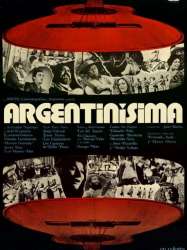
Argentinísima (1972)
, 1h54Directed by Fernando Ayala, Héctor Olivera
Genres Documentary, Musical
Themes Films about music and musicians, Documentary films about music and musicians, Documentaire sur une personnalité, Musical films
Actors Astor Piazzolla, Jorge Cafrune, Nelida Lobato
Roles Self
Rating67%






Prisioneros de una noche (1962)
Directed by David José Kohon
Genres Drama
Actors María Vaner, Alfredo Alcón, Osvaldo Terranova, Astor Piazzolla, Alejandro Anderson
Rating69%





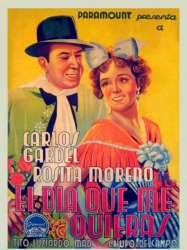
El día que me quieras (1935)
, 1h22Directed by John Reinhardt
Origin USA
Genres Drama, Musical
Themes Dance films, Musical films, Tango films
Actors Carlos Gardel, Tito Lusiardo, Rosita Moreno, Astor Piazzolla
Roles Newspaper's kid
Rating68%





The film tells the story of Julio Arguelles, the son of a wealthy Buenos Aires businessman, who wants to marry Margarita, who is considered to be below his social status. Despite the father’s opposition they marry and elope together. The film then traces the life of the couple and, following the death of the young Margarita, concludes with Julio’s rise to fame as a tango singer. Astor Piazzolla, who in later life would revolutionized traditional tango, played a cameo role as a young paper boy.
Sound

The Journey (1992)
, 2h20Directed by Fernando Solanas
Origin Argentine
Genres Drama
Actors Marc Berman, Dominique Sanda, Fernando Siro, Fito Páez
Roles Original Music Composer
Rating70%





Le jeune Martin abandonne sa Terre de feu natale, à l'extrême sud de l'Argentine, pour un long voyage initiatique en Amérique Latine.
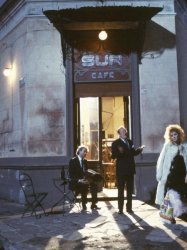
The South (1988)
, 2h7Directed by Fernando Solanas, Gaspar Noé
Origin Argentine
Genres Drama, Musical
Themes Politique, Films about Latin American military dictatorships
Actors Susú Pecoraro, Miguel Ángel Solá, Philippe Léotard, Ulises Dumont, Fito Páez, Gabriela Rosana Toscano
Roles Musician
Rating72%





Floreal is released from prison prior to the end of a military coup d'état in 1983. He discovers his wife has cheated on him and is not sure he wants to return to his former life and family. A friend, "El-Negro", who was killed during the military coup, appears in the night with a special mission: to help Floreal face what has happened when he was serving time in prison. El-Negro helps him to live through the important events that happened in his absence. El-Negro helps him get past his anger, understanding how hard it was to endure such a difficult time and how the military coup had crushed people's lives. When El-Negro finally tells him he must return, Floreal realizes he must be strong and, like his coup-stricken country, pick up and go on with his life.

Tangos, the Exile of Gardel (1985)
, 1h59Directed by Fernando Solanas
Origin France
Genres Drama, Documentary, Musical
Themes Dance films, Films about music and musicians, Politique, Musical films, Films about Latin American military dictatorships, Tango films
Actors Philippe Léotard, Marie Laforêt, Lautaro Murúa, Miguel Ángel Solá, Marina Vlady, Georges Wilson
Rating71%





La vie d'un groupe d'Argentins émigrés à Paris durant la dictature militaire en Argentine (1976-1983). Le groupe décide de monter un ballet de tango en l'honneur du chanteur et compositeur de tango Carlos Gardel. Le film est aussi l'occasion de présenter le déracinement et le quotidien de ces exilés.

Henry IV (1984)
, 1h35Directed by Marco Bellocchio
Origin Italie
Genres Drama
Themes Medical-themed films, Théâtre, Films about psychiatry, Films about disabilities, Films based on plays
Actors Marcello Mastroianni, Claudia Cardinale, Leopoldo Trieste, Paolo Bonacelli, Giuseppe Cederna
Roles Original Music Composer
Rating63%





Prenant part à une cavalcade sous le costume d'Henri IV, un jeune homme désarçonné perd la raison et croit être Henri IV.
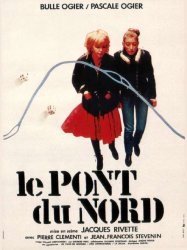
Le Pont du Nord (1982)
, 2h9Directed by Jacques Rivette
Origin France
Genres Drama, Comedy, Fantasy
Themes Pont
Actors Bulle Ogier, Pascale Ogier, Pierre Clémenti, Jean-François Stévenin, Mathieu Schiffman
Roles Music
Rating67%





Le Pont du Nord stars Bulle and Pascale Ogier as two women who randomly meet and investigate a strange and surreal mystery together involving a strange package and several characters all named Max.
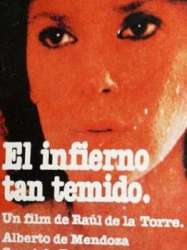
So Feared a Hell (1980)
Directed by Raúl de la Torre
Genres Drama
Actors Graciela Borges, Alberto de Mendoza, Arturo García Buhr
Roles Music
Rating64%





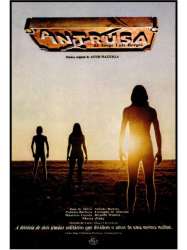
The Intruder (1980)
, 1h40Origin Bresil
Genres Drama, Horror, Historical, Western
Themes Films about sexuality, LGBT-related films, LGBT-related films, LGBT-related film
Actors José de Abreu, Maria Zilda Bethlem
Roles Original Music Composer
Rating64%






What's Autumn? (1977)
, 1h55Directed by David José Kohon
Genres Drama
Actors Alfredo Alcón, Dora Baret, Alberto Argibay, Aldo Barbero, Javier Portales
Roles Music
Rating71%






Armageddon (1977)
, 1h36Directed by Alain Jessua
Origin France
Genres Thriller, Crime
Actors Alain Delon, Jean Yanne, Renato Salvatori, Marie Déa, Michel Duchaussoy, Michel Creton
Roles Music
Rating60%





Armaguedon, nom d'emprunt de Louis Carrier, cherche à se venger de la société en défiant la police par des menaces terroristes. La police fait appel à un psychiatre pour en venir à bout.

Lumière (1976)
, 1h35Directed by Jeanne Moreau
Origin France
Genres Drama, Romance
Actors Jeanne Moreau, Keith Carradine, Bruno Ganz, Niels Arestrup, Lucia Bosè, Francine Racette
Roles Original Music Composer
Rating59%





Sarah, une actrice qui approche de la quarantaine, a invité trois amies à passer ses vacances en Provence. C'est le prologue de ce qui s'est passé il y a un an à Paris avec un homme que Sarah considérait depuis longtemps comme un ami platonique. Elle venait de terminer un film, terminant également sa liaison avec le réalisateur, et était sur le point de recevoir un prix…
 Connection
Connection
